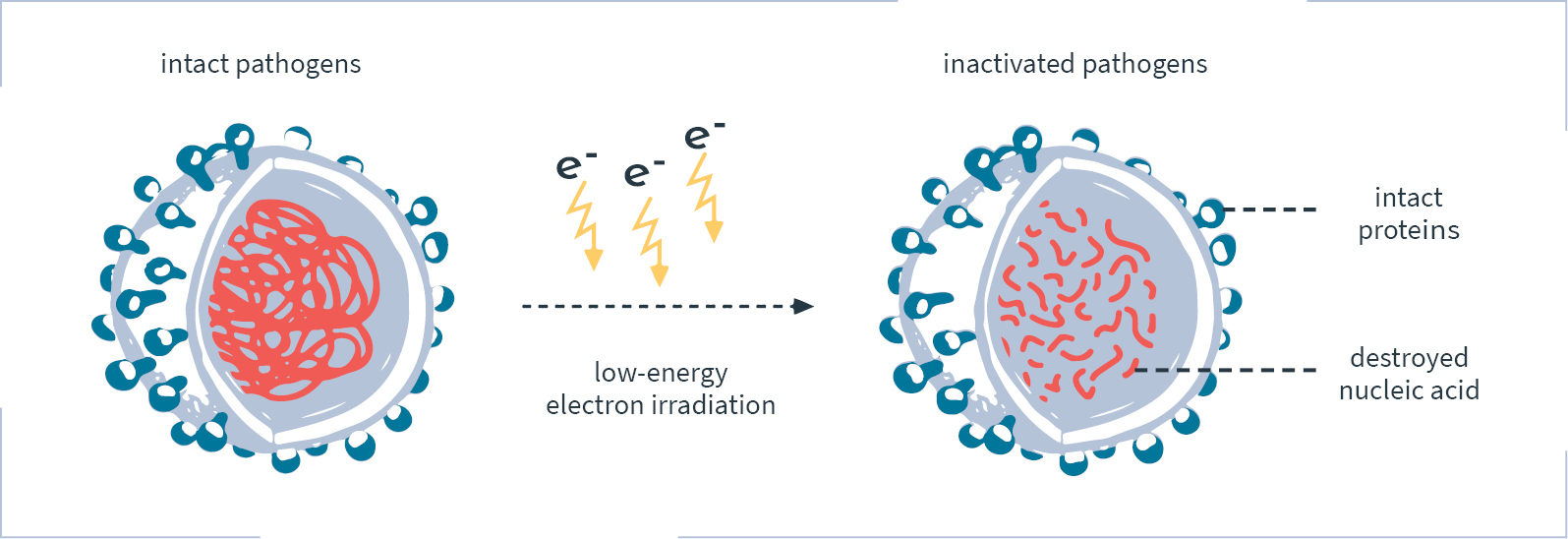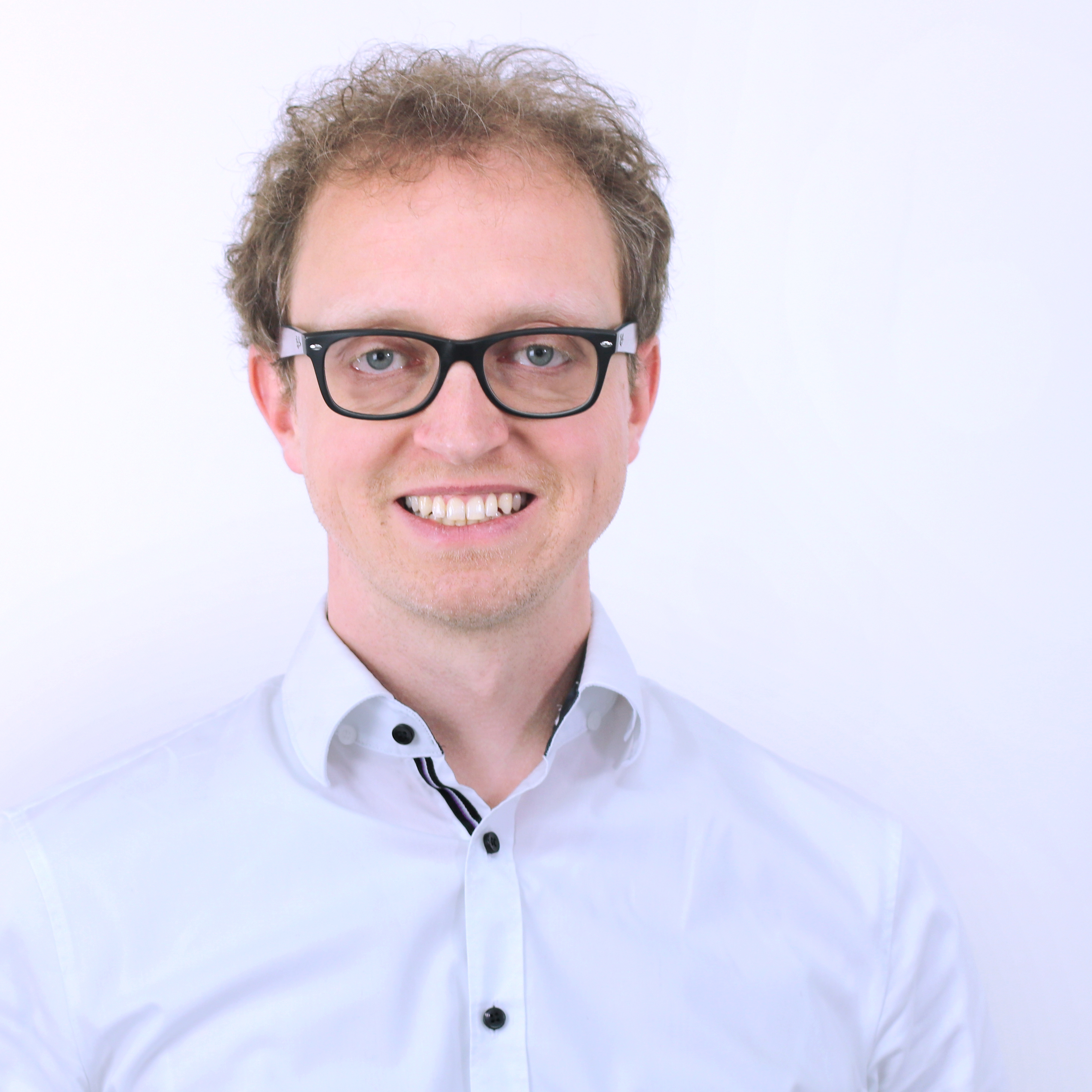KyooBe Tech GmbH
Next generation vaccine production
For decades, conventional inactivated vaccines have been produced by killing pathogens with toxic chemicals. However, this process often changes the surface structure of the pathogens to such an extent that the immune system is only able to induce a weak response. A company called KyooBe Tech GmbH is now offering a new method that uses low-energy electrons to inactivate the pathogens. Vaccines produced in this way are much higher quality, making them safer and more effective.
Administering vaccines trains the immune system to recognise pathogens and to combat them quickly and effectively in case of infection. Either live or inactivated vaccines can be used. Live vaccines contain attenuated pathogens which are no longer able to trigger disease, but which, due to their intact structure, provide strong immune protection. For example, the immunity obtained with the measles, mumps and rubella (MMR) vaccine lasts a lifetime.
Inactivated vaccines on the other hand consist of inactivated pathogens. Inactivation through formaldehyde, a toxic chemical, has been the most common approach until now. Formaldehyde penetrates the pathogen and changes the structure of its proteins and genetic information, thus killing it. This method partially destroys the pathogen’s surface proteins, resulting in a much weaker immune response than with live vaccines. For this reason, inactivated vaccines often contain adjuvants - i.e. substances which enhance the body’s immune response to an antigen. Moreover, the protection achieved, for example against influenza, hepatitis A or tick-borne meningoencephalitis (TBE), is limited in time, which is why it must be refreshed regularly.
Low-energy electron beams for customised inactivation
 Irradiating a pathogen with low-energy electron irradiation (LEEI) damages the genetic information (nucleic acid) inside the pathogen, while the proteins on the surface remain intact. © KyooBe Tech GmbH
Irradiating a pathogen with low-energy electron irradiation (LEEI) damages the genetic information (nucleic acid) inside the pathogen, while the proteins on the surface remain intact. © KyooBe Tech GmbHA company called KyooBe Tech GmbH from Leinfelden-Echterdingen, founded in February 2020, offers an alternative method for inactivating pathogens. The main target is the genetic information, i.e. the nucleic acid of the pathogen. The nucleic acid is broken down and cut into small pieces using low-energy electron irradiation (LEEI), so that the pathogen can no longer replicate. The protein structure on the surface of the pathogen, which is important for the immune system to induce a strong response, remains intact.
The process was developed by a consortium of four Fraunhofer Institutes from Leipzig, Dresden and Stuttgart. The biggest drawback of the LEEI technique is the low penetration depth of the low-energy electrons. To ensure that the pathogen is completely killed off during irradiation, a layer thickness of 300 µm must not be exceeded. To achieve this, a pump and roll system has been developed. This system guides the pathogen-containing liquid in the form of a thin film through an irradiation chamber.
The feasibility of the technology ("proof of concept") has already been demonstrated in several laboratory tests for polio or influenza viruses as well as for other pathogens such as bacteria. Compared to the formaldehyde method, the new method leads to a significantly higher yield of inactive pathogens (95% compared to 40-60%). It also results in better vaccine quality as it leaves the protein structure intact and does not involve the use of toxic formaldehyde. It now takes just a few hours to produce vaccine quantities that previously took 2-3 weeks due to the long reaction time of formaldehyde. Compared to treatment with high-energy (gamma) radiation, which is an alternative option, but can cause ionisations that damage tissue and DNA, LEEI requires significantly fewer radiation protection measures.
KyooBe Tech is responsible for market launch
As the patent owner, the Fraunhofer Society licensed the method in 2017 to Bausch+Ströbel Maschinenfabrik Ilshofen GmbH + Co KG, a manufacturer of systems for filling medicines. KyooBe Tech, a wholly owned subsidiary, will drive forward and be responsible for the technology transfer of the prototype to a pharmaceutically compatible production system.
-
-
-
-
The LEEI technology is implemented with the help of a patented pump and roll system. A rotating roll produces a thin liquid film which is irradiated with low-energy electrons and then drawn off the roll system. 1. irradiation chamber, 2 low-energy radiation source, 3 pump and roll system, 4 rotating roll, 5 thin liquid film, 6 squeegee, 7 peristaltic pump, 8 solution with live pathogens, 9 solution with inactivated pathogens. © KyooBe Tech GmbH
The LEEI technology is implemented with the help of a patented pump and roll system. A rotating roll produces a thin liquid film which is irradiated with low-energy electrons and then drawn off the roll system. 1. irradiation chamber, 2 low-energy radiation source, 3 pump and roll system, 4 rotating roll, 5 thin liquid film, 6 squeegee, 7 peristaltic pump, 8 solution with live pathogens, 9 solution with inactivated pathogens. © KyooBe Tech GmbH
"We are in contact with all major vaccine manufacturers in the European market. We have already initiated 'proof of concept' studies with pathogens from some of these companies," explains Mario Bott, one of the managing directors of KyooBe Tech. At present, the young company is still in the establishment phase; the market launch of the serial product is expected in 2-3 years’ time. By then, the prototype, which currently weighs 8 tonnes and has a floor area of 4x4 metres, should have shrunk to the dimensions of a large refrigerator.
 Mario Bott, managing director of KyooBe Tech GmbH. © KyooBe Tech GmbH
Mario Bott, managing director of KyooBe Tech GmbH. © KyooBe Tech GmbHDespite the enormous advantages of the LEEI method, KyooBe Tech is not primarily aiming to convert existing production lines, as these vaccines would require new approval. "But over the long term and as a future goal, we want to set a new gold standard in pathogen inactivation with our technology," said Bott. This goal is already imprinted in the company’s name, derived from the English phonetic spelling of the letters Q (for quality) and B (for biology). The company's major focus is on the high biological quality, and thus safety, of its products. In comparison with live vaccines, inactivated vaccines produced using LEEI will – due to the fact that the proteins’ surface structures remain intact – require considerably lower quantities of the adjuvants responsible for the side effects. In addition, KyooBe Tech expects there to be benefits when it comes to producing multiple vaccines and seamlessly integrating this into a continuous production process. The LEEI technology platform is expected to provide customers with greater flexibility and versatility.
New impulses for pharmaceutical production processes
KyooBe Tech is not just an equipment supplier, but also supports customers in optimising the pathogen inactivation process. Every pathogen requires individual parameters with regard to the pathogen concentration and radiation dose used for complete inactivation while maintaining the best possible surface structure.
The company has a strongly customer-centred approach and wants to use its knowledge to provide impetus and help shape production processes. The pharmaceutical product landscape has changed over the past decade: the diversity of processes and products has increased considerably and minor diseases are also increasingly being addressed. This is exactly where KyooBe Tech comes in. "My interdisciplinary team of engineers, biotechnologists and process engineers are looking at biological process chains and asking how they can support or help promote this change through their expertise and new methods," said Mario Bott explaining the approach. "We actively approach clients and want to get involved in strategy discussions." The new generation of vaccine production is only the first step in this approach to innovation.